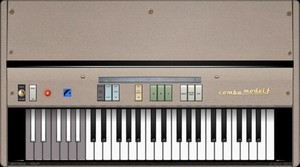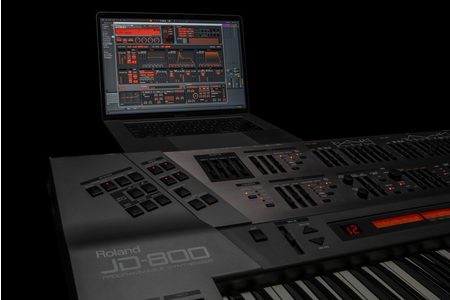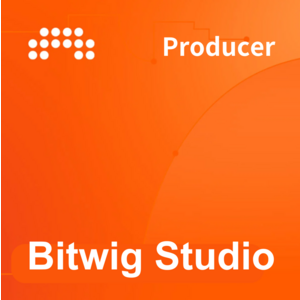非常榮幸這次能在柏林訪問聲音與媒體藝術家 Marco Donnarumma,他專研並書寫關於身體與聲音之連結。出生於義大利的那不勒斯,Marco Donnarumma 同時身兼藝術表演者與學者得身分,已在超過60個國家中呈現與表演他的作品。在科技與藝術創作之間,他找到了一個很好的平衡點且同時融合自身的美學於表演之中。筆者萬分榮幸能到他位於柏林的工作室進行訪問,以下是我們的訪談紀錄。
Photo by Jie Ting Jiang
當我認識你與你的表演時,你正在倫敦Goldsmiths大學就讀博士,或許你能談談在你念博士之前?你是如何進入聲音這項領域的呢?你的創作背景又是如何的情況呢?
Marco: 在我就讀博士之前,已經專注在身體與演算(電腦)上,過去我完成聲音設計碩士學位,於一間位於蘇格蘭的愛丁堡大學,念研究所的其間也是我用XTH Sense創造樂器的時期,也是過去五年來一直在玩的樂器。
Marco: 我一直深陷於音樂創作之中,一直都是,而且,你知道的我是一個貝斯手,所以我一直都在做電子音樂,仍然一直在做另一面向的專案。我猜想改變我近幾年來的表演方式是 ─ 我想創造一些東西,可以讓我使用科技,但同時它又不會讓觀眾聚焦在技術本身,所以我想讓觀者看著表演者的身體呈現,而不是看技術本身。這也是我使用XTH想得到的結果,因為使用XTH Sense,你可以雕碩低頻的聲音,這使得在這類的聲音、各種來自人體的生物性聲音變得格外有趣。 聲音總是在那裡,在所有經驗中,我想這幾年來我也更深入的研究,真正深入聲音的物質性和聲音所帶來的效果。
你認為你以前的練習 ─ 身為一個貝司手,這影響你現在對聲音創作的看法嗎?
Marco: 嗯... 我想我有一個非常清楚的想法是如何使用聲音做特定的事情, 這是非常肯定的事,所以我可以用更精確的方式掌握聲音。 此外,我開始在自己的練習中,以聲音的術語思考。 聲音總是我工作中的第一選用的媒材,它也跟作品融為一體。 現在,我創造的一切都有很強烈的聲音元素。 作品不是只關於聲音被播放,而是關於如何使用聲音,將人體與科技或演奏者的身體與觀眾的身體做連結。
“Hypo Chrysos”, photo provided by Marco Donnarumma.
當我瀏覽你的網站時,發現你做了很多與XTH Sense相關的創作。 為什麼你想繼續使用這樣特殊的 工具在作品上呢?
Marco: 好,我有兩種想法來回答這問題,之所以我會用它 (XTH Sense) 如此多年是因為我覺得它是一個可塑性非常高的工具,它的原則非常簡單,就是將身體的聲音放大,之後這將取決於你的個人美學以及你個人的想法來使用這些來自身體的聲音,像是結合影像、燈光或是與空間產生共鳴,所以這就是為什麼我一直使用它 (XTH Sense) 的原因。另一個原因是,我使用的次數越多,我帶的工作坊也就越多,並且發現更多關於 XTH Sense 的想法, 而且作品的發展是持續在進行的,所以你在我的網站上看到第一個使用XTH Sense作品是花一年做出來的,之後每年都有新進展的創作。 這是一個迭代的過程,所以它不只總是相同的樂器,它是經過多年的發展,尤其是這些年來,我帶過的工作坊,這些過程讓我以不同的方式思考聲音和電腦運算,這是非常有幫助的。 我大概帶過50 - 60個工作坊,從觀察人們用不同的方式使用 XTH Sense ,你當然也會被激發一些想法 ,這真的是一個不容忽視的助力。答案的第二部分是,我使用的 XTH Sense 有些轉變, 現在 XTH Sense 是我使用的工具之一,但我也做客製化的燈光或使用其他類型的感測器, 實際上,在未來的2或3年裡,我有個新的工作項目是關於建造自動機器人,所以正在一個位於柏林的神經機器人研究實驗室工作。 現在,我們不想帶入細節,但簡要來說,我們將建立一個人工智慧機器, 因此這也會將是一個重點 - 從僅使用XTH Sense轉移到與其他技術一起使用。
你曾與舞者合作演出 ─ “[radical] - Signs of Life” 由 Heidi Boisvert 主導與編舞。 將 XTH Sens e帶給不同的創作背景的人是如何的經驗呢?
Marco: 是的, Heidi 的願景是創造一個關於生物物理學的舞蹈,它包括空間的聲音和回應式的即時影像, 我、她和她的團隊合作使用 XTH Sense 作為舞者身體和其他媒體之間的橋樑。 XTH Sense 的經驗真的取決於一個人認識自己身體的方式,如果你把它(XTH Sense)給舞者們,他們起初感覺有點怪異,因為隨著他們的舞動而產生聲音,他們並不習慣感測器直接的反饋, 但這現象也是很直觀的,他們知道如何靈活運用他們的身體,他們知道怎麼運用他們的肌肉,所以也發現發饋這件事的有趣性,至少在我的經驗中是有很有意思的,因為舞動身體是他們深知事情,如何通過訓練和紀律掌握身體。如果你把它(XTH Sense)給音樂家,他們不一定向舞者那樣了解自己的身體,但當然他們有更多地知識在聲音和音樂上, 所以他們會從動態上發現更多關於聲音方面的事,而不是編排的面相。
“Corpus Nil”, photo provided by Marco Donnarumma.
在 “Corpus Nil” 中,不像你以前的表演的方式,你隱藏大部分的身體,只顯露一些部分,此外,燈光從舞台下方投射,使得你的身體看起來十分巨大,像另一個生物一般。 這個作品是如何發展的呢?
Marco:前提是我已經做了很多關於手勢音樂的作品 ─ 我使用全身當作聲音的基礎,在這裡我大多使用胳膊和手。 [...] "Corpus Nil" 背後的想法是想脫離一點這種用法,只因為我做很多次這類表演了,四年後,我仍然在做相同的方法,所以我做了一些新的探索,因此我想到的第一件事是如何使用身體不同的部位。直到現在,我一直在用這種方式,思考著還有什麼其他我能做的?因為我不是訓練過的舞者,我仍在學習如何使用身體就像我創造不同的藝術品般,我想 “先改變感測器的位置,看看會發生什麼事” 。當我把它(傳感器)戴在上手臂的這一部分(上臂,靠近肩膀),然後無論手做什麼都不再那麼重要了,因為感測器捕捉肩膀和背部肌肉的運動,所以這是一種以技術性的方式去強迫自己思考不同類型的運動,但我真的被困在以這種手勢上的呈現方式上(手勢和手指移動),因為我一直在這樣訓練中很長一段時間。在編排 "Corpus Nil" 表演之中,我仍然試圖使用手,而實際上,有一些早期測試的照片,你看到沒身上並沒有塗料,而我還在使用手勢,這真的很不好,我那時正在努力找到一種不同的呈現方式,後來我想 “好吧,我仍然使用手的時候太多了,把它們塗黑吧。” 這是一種抹去它們的方式,即使我試圖用手做控制裝置,這將變得無意義,因為觀眾看不到他們,這作品的轉變開始變得更有趣,我開始學會如何移動身體其餘的部分,這已是逃離過往不管是精神層面還是肉體的實踐,也就是逃離那些迫使我進入某些既定的運動。所以,通過塗黑手臂和頭部,以及比較晚發展的部分 ─ 我迫使自己用只是身體的上臂、肩膀和背部的一部分的編舞。在表演期間,我強非常調身體在空間中的伸展!要達到編排所需的狀態是相當困難的,因為我需要盡可能的伸展,且往返向旋轉手臂,這就是我在舞台上身體所呈現的狀態(幾乎不像是人類)。
Marco: 這個編舞的 一個重要的靈感源自大型動物的誕生,你有見過剛出生的馬嗎?這真的很迷人,因為他們有相對巨大的腿,對於他們的身形來說,腿部比例顯得巨大,然後他們必須在出生的幾小時內,開始學會如何站起來以及跑步。你看他們的腿相對於身體的其他部分是如此地不成比例,這是他們學習的第一件事,在出生幾個小時後,他們得這麼做,真的非常有趣,因為這是動物們來到世界的方式,非常的掙扎,而這是一個必要的掙扎,迫使自己能站立。試著想像一下,想像他們在自己的棲息地,如果他們不能在十分鐘內站起來,他們必死無疑,這是非常深刻的事。現在,如果你在 YouTube 看他們出生的影片,你會看牧場和照顧他們的人,但這不是他們的真實生活,你知道他們本應該在野外,而他們出生的那刻便是一個重大的關鍵。因為發現動物身體性的掙扎,讓我發展出有意思的編排和概念。
“Corpus Nil” live at ZKM, Germany, 2016. Courtesy of Onuk@ZKM.
“Corpus Nil” live at ZKM, Germany, 2016. Courtesy of Onuk@ZKM.
在剛剛說明中, “Corpus Nil” 創作中,做了身體上的改變,那音樂的部分呢? 你認為音樂也在這次的創作中改變了嗎?
Marco: 是的,我的意思是它是一種反饋的循環。我無法說是什麼部分先被改變了,因為這是一整個實驗放置感測器於不同位置之過程,促使我嘗試不同的編排。聲音是一個完全不同的故事,我正在研究一些其他的東西,像是如何將肌肉的特定頻率轉換聲波,這種研究與編舞直接相關,因為這件作品的編排主要專注在張力,壓力和均衡上,所以當我執行時,我的身體處在非常緊繃的程度,這樣做是有目的,因為我想調查一些特定類型的肌肉活動,以及我如何將其聲響化。但是聲音的部分,舉例來說,也和身體作息為了適應外部環境的同步化有關,感覺像是一種恍惚的狀態,所以在表演中的某個時候,使用低頻聲響搭配跳動的效果 ─ 這樣的脈動聲、這樣的聲音設計是有目的地用來在觀眾以及我自己身上去製造「同步化」。
感謝你的分享!
Marco: 謝謝!
Artist’s website: http://marcodonnarumma.com/
***
Hybrid Aesthetics from Marco Donnarumma - The mixture of Body, Technology And Sound
We are honored to have an interview in Berlin with sound and media artist Marco Donnarumma, who works, think and write on the connection of the human body with sound. Born in Naples, Italy, Marco Donnarumma is a performance artist and scholar, who has already presented and performed his artworks in over 60 countries. Working with technology and art, he does not only find a great balance between the two but also shows a unique aesthetics in his performances. I had a great chance to visit him in his studio in Berlin. It was such a pleasurable experience. Below is our interview.
When I got to know you and your performances, you were studying for a Ph.D. in Goldsmiths, University of London. May I ask you what did you do before Goldsmiths? Why and how did you get into sound? What’s your creative background?
Marco: Before the Ph.D., which focused on corporeality and computation, I did a master by research in sound design at University of Edinburgh in Scotland. That’s actually where I created the XTH Sense, the instrument that I have been playing in the past five years.
Marco: I have been making music since always, really. And, you know I am a bass player, so have been always making sounds. I have been also doing electronic music and I still do it with another side project. Then, I guess what changed my way of approaching the performances I was doing several years ago was that I wanted to create something that would allow me to use technology, but, at the same time, it would not make the audience focus just on the technology itself. So, I wanted people to look at the performer’s body rather than look at the technology. That’s how I came to the XTH Sense. And then, because with the XTH Sense you can sculpt this low-frequency sound, it makes it very interesting to work with those kinds of sounds, all kinds of bioacoustic sounds from the human body. That was when I made this kind of switch. So sound has always been there I think I just got more into it through the years, and going really into the depth of sound materiality and what sound can affect, in terms of all these experiences.
Do you think your previous practice - you were a bass player - influences how you think about sound now?
Marco: Hm...well, I think I have a much clearer idea of how I can use sound to do specific things. That’s for sure. So I can master sounds in a more precise way. Also, I started thinking in sonic terms in my own practice. Sound is always the first material in my work, so much that it became really integral. So now, everything I create has a very strong sonic component. It’s not only about sound being played back, but it’s about how to use sound to connect the human body with technology or the performer's body with the bodies of the audience.
When I looked through your website, I found out that you did a lot of artworks with the XTH Sense. Why do you want to keep using especially this instrument in your works?
Marco: Okay, there are two ways to answer this one. So, the reason why I kept working on it for so many years is that I think it is a very flexible instrument. It’s based on a simple principle, that is, amplifying sound from the body, and it’s really up to your own aesthetic and your own ideas what kind of use you want to make of those sounds, how you want to translate them. If you want to use them with video, with lights or to resonate spaces. So this was one of the reasons why I kept using it. And the other reason is that the more I used it and the more workshops I taught about it, the more ideas I found. And also the development has been continuous, so the first of the works you have seen on my website came out after one year that I was using the XTH Sense, and every year a new work followed. It has been an iterative process so it’s not just always the same instrument. It developed through the years and then that development allowed me to think of sound and computing in different ways. Especially with the workshops that I taught in these years, that was very useful. I have been teaching maybe 50 or 60 workshops in the past years. That’s incredibly helpful because you see how people different from you use it (the XTH Sense). You get other ideas as well. The second part of the answer is that my use of the XTH Sense is now kind of shifting. Now the XTH Sense is one of the instruments I use, but I also make custom lights or use other kinds of sensors. And, actually, the new project I’m working on here (in Berlin) for the next 2 or 3 years in Berlin, now involves constructing autonomous robots, so I’m working with a neurorobotics research lab here in Berlin. Now, we don’t want to get into the details, but we gonna build an artificially intelligent machine there. So this will also shift the focus from using only the XTH Sense to using it together with other technologies.
I found out that you have collaborated with dancers in the performance - “[radical] - Signs of Life” by Heidi Boisvert. How was the experience to bring XTH Sense to different people?
Marco: Yes, so Heidi’s vision was to create a piece of biophysical dance, including spatial sound and responsive real-time video. So I collaborated with her and her team to use the XTH Sense as a bridge between the dancers’ bodies and the other media. The experience of the XTH Sense really depends on the way one knows her own body, so if you give it (the XTH Sense) to a dancer for instance, to them at first it’s a little weird because they are not used to this direct feedback with sound as they dance. But then it’s also very intuitive. They know how to use their body, they know how to dance their muscles in the one way of the other, so they find it interesting, at least in my experience, because it’s something they know well, how to master the body through training and discipline. Then, if you give it to someone who is a musician, they are not necessarily as well informed as dancers about their own bodies, but, of course, they are more informed about sound and music. So, they will find movements that are maybe more related to how something sounds rather than what kind of choreographies they can produce.
In “Corpus Nil”, unlike your previous performances, you hide most of your body and show only some parts of it. Also the light is projected from under the stage, which makes your body look so extraordinary and like another creature. How did the idea develope?
Marco: The premise is that I have been doing a lot of works on gestural music, where I used my whole body for performances based on sound. There I would mostly use my arms and hands. […] The whole idea behind Corpus Nil is to get a little bit away from that kind of approach. Just because I have been doing those performances so many times, and I’m still doing them after 4 years from their creation, ...so I wanted to find something new to explore. So the first thing I thought about was how I can use differently my body. I have been using it in this way until now and what other things I can do? Because I’m not a dancer by training, I’m learning how to use the body as I create different artworks. I thought “let’s change the position of the sensor first and see what’s happens”. When you wear it (the sensor) on this part of the arm (upper arm, close to the shoulder), then what you do with your hands is not so important anymore because the sensor captures the movement of the shoulder and the muscle here on the back or the upper torso. And so this was a technical way of forcing myself into thinking about different kinds of movement. Then, I was really stuck with this kind of gestures (hand gestures and finger movements) because I had been doing them for a long time, my training was there. So I was still trying to use my hands while creating the choreography for Corpus Nil. I actually have some pictures of some early tests. You see there’s no paint and I was still using the hands. That wasn’t good. I was struggling to find a different way. Then I thought: “OK, I’m still using too much my hands so I’m gonna paint them black.” It’s a way of erasing them. Even if I tried to do something with my hands, it was pointless because you could not see them. That’s actually where the thing started to be more interesting. I started to be able to learn how to move rest of body. It was really about escaping certain mental and corporeal kind of practice that was forcing me into certain movements. So by painting the arms and the head as well - that came a little bit later - I was forced to think in choreographic terms using only these parts of the body (upper arms, shoulder, and part of back). During the performance, I emphasize those parts of the body by stretching them out in space, a lot! To get into the positions required by the choreography is quite hard because I need to stretch out as far as I can and the arms are rotated the other way around. That’s how the body on stage provides that feeling (of being almost unhuman).
Marco: A great inspiration for this choreography was the birth of big animals. Have you ever seen baby horses when they’re just born? It’s really fascinating because they have these massive legs, which are too big for their tiny bodies… and then they learn how to stand up and run in just few hours after their birth. You see that their legs are so disproportionately big in respect to the rest of their bodies. So, that’s the first thing they learn. They do this like after couples of hours they are born. And it’s very interesting because it’s the way they come into the world as animals,…it’s a real struggle. It's an essential struggle to stand on your feet. Try to imagine that, imagine them in their own habitat, right? If they don’t stand up in ten minutes, they are dead. There’s something very profound in that. Now, if you watch a Youtube video of their births you see ranches and people taking care of them, but that’s not the reality of their life. You know they are just in the wild and that’s a critical moment when they are born. So there’s a physical struggle in this process which I found very interesting both choreographically and conceptually.
You just said in “Corpus Nil” your body changed. How about the music? Do you think it changed as well?
Marco: Yes, I mean it’s a kind of feedback loop. I could not say what changed first. It was a whole process where I experimented with different locations of the sensor, and that drove me to try out different choreographies. And the sound was a completely different story. Then, I was investigating in some other stuff: how to sonify specific frequencies from the muscles. That kind of investigation is directly connected to choreography, because the choreography of the piece is focused on tensions, pressures and equilibrium. So there’s an extremely high level of tension in my body as I perform that piece. That’s on purpose because I wanted to investigate some particular kinds of muscle activity and how I can sonify that. But the sound part, for instance, it also related to entrainment, like kind of trance states. So, the use of sonic drones with this beating effect that happens at some point during the performance, the pulsating sound, that kind of sound design is made on purpose to produce this kind of entrainment in the audience and in myself too.
Thank you so much for your sharing!
Marco: Thank you!
Artist’s website: http://marcodonnarumma.com/
Thanks to Marco Donnarumma for help with the English version of this article.


























討論區
目前尚無評論